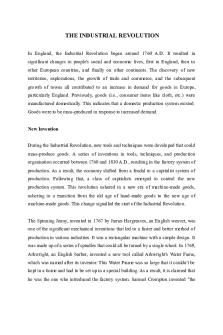The 2nd Industrial Revolution in America and Big Business PDF

| Title | The 2nd Industrial Revolution in America and Big Business |
|---|---|
| Author | Ilya Bzh |
| Course | Civilisation américaine - US |
| Institution | Université Catholique de l'Ouest |
| Pages | 2 |
| File Size | 77.4 KB |
| File Type | |
| Total Downloads | 50 |
| Total Views | 136 |
Summary
Présentation orale à l'examen...
Description
The 2nd Industrial Revolution in America and Big Business The 2nd Industrial Revolution in America The Second Industrial Revolution, which began in the middle of 19th century (1850-1970). It was a period of growth for pre-existing industries and expansion; such as the steel, oil and electricity fields. Adam Smith was the father of modern economics. He talked about free enterprises and free markets. Developed the idea of Division of Labour, being more efficient and productive. Alexander Hamilton was the 1st secretary of treasury (originally a banker financier) under Thomas Jefferson’s government. He had the idea of a central bank that could gather each state’s debt. The 1st National Bank was founded (20 years, Charter 1791-1811). During the Second Industrial Revolution, the existing manufacturing and production methods were improved. For example, steel replaced iron in the building. It was strong, and it was cheap. So, it made possible to build rail lines at competitive cost and spread transportation. Steel also facilitated the construction of ships and larger bridges. Thomas Edison worked on the discovery of electricity. This, in addition to the appearance of the first efficient commercial electrical generators in the 1870s, made public electricity possible. Gustavus Swif (meat packing) Without certain inventions from the Second Industrial Revolution, some of the ways we communicate today wouldn’t be possible. For instance, in 1876, Alexander Graham Bell invented the telephone. Later on, in 1901, Guglielmo Marconi sent radio waves across the Atlantic Ocean for the first time. In October 1908 Henry Ford created the Model T. His automobile was much cheaper than other cars because it was made on an Assembly Line using mass production. Public health also improved greatly. This was thanks to the construction of sewage systems in cities. This was accompanied by the passage of laws that regulated filtered water supplies and minimum standards of water quality. These two measures reduced the rates of infections and death from many diseases. 1869: 1st Trans Continental Rail Line between Missouri and California made by 2 companies: Leland and Stanford. America is now linked from coast to coast (Manifest Destiny).
Those railroads created a national market, but at the same time, they were also a market themselves (needing iron, wood, cloth, coal…).
Big Business Definition of Big Business: term for large corporations and unfair business practices. => 1st Big Business of America. Cornelius Vanderbilt developed a huge railroad market, while John D. Rockefeller wanted to work with oil and thus captured oil refining. He first began to do horizontal integration, controlling 90% of the oil market in America, then he also practiced vertical integration (oil market ended up with no competition as Rockefeller was almost owning everything)....
Similar Free PDFs

Industrial Revolution in Canada
- 5 Pages

THE Industrial Revolution
- 4 Pages

The third industrial revolution
- 2 Pages

Industrial Revolution
- 2 Pages

Industrial Revolution
- 19 Pages

DOING BUSINESS IN AMERICA 1
- 3 Pages

Industrial Revolution Essay
- 9 Pages

Industrial Revolution DBQ
- 8 Pages
Popular Institutions
- Tinajero National High School - Annex
- Politeknik Caltex Riau
- Yokohama City University
- SGT University
- University of Al-Qadisiyah
- Divine Word College of Vigan
- Techniek College Rotterdam
- Universidade de Santiago
- Universiti Teknologi MARA Cawangan Johor Kampus Pasir Gudang
- Poltekkes Kemenkes Yogyakarta
- Baguio City National High School
- Colegio san marcos
- preparatoria uno
- Centro de Bachillerato Tecnológico Industrial y de Servicios No. 107
- Dalian Maritime University
- Quang Trung Secondary School
- Colegio Tecnológico en Informática
- Corporación Regional de Educación Superior
- Grupo CEDVA
- Dar Al Uloom University
- Centro de Estudios Preuniversitarios de la Universidad Nacional de Ingeniería
- 上智大学
- Aakash International School, Nuna Majara
- San Felipe Neri Catholic School
- Kang Chiao International School - New Taipei City
- Misamis Occidental National High School
- Institución Educativa Escuela Normal Juan Ladrilleros
- Kolehiyo ng Pantukan
- Batanes State College
- Instituto Continental
- Sekolah Menengah Kejuruan Kesehatan Kaltara (Tarakan)
- Colegio de La Inmaculada Concepcion - Cebu







